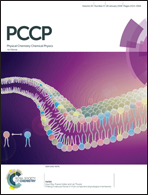Combining experimental and modelling approaches to study the sources of reactive species induced in water by the COST RF plasma jet†
Abstract
The vast biomedical potential of cold atmospheric pressure plasmas (CAPs) is governed by the formation of reactive species. These biologically active species are formed upon the interaction of CAPs with the surroundings. In biological milieu, water plays an essential role. The development of biomedical CAPs thus requires understanding of the sources of the reactive species in aqueous media exposed to the plasma. This is especially important in case of the COST RF plasma jet, which is developed as a reference microplasma system. In this work, we investigated the formation of the OH radicals, H atoms and H2O2 in aqueous solutions exposed to the COST plasma jet. This was done by combining experimental and modelling approaches. The liquid phase species were analysed using UV-Vis spectroscopy and spin trapping with hydrogen isotopes and electron paramagnetic resonance (EPR) spectroscopy. The discrimination between the species formed from the liquid phase and the gas phase molecules was performed by EPR and 1H-NMR analyses of the liquid samples. The concentrations of the reactive species in the gas phase plasma were obtained using a zero-dimensional (0D) chemical kinetics computational model. A three-dimensional (3D) fluid dynamics model was developed to provide information on the induced humidity in the plasma effluent. The comparison of the experimentally obtained trends for the formation of the species as a function of the feed gas and effluent humidity with the modelling results suggest that all reactive species detected in our system are mostly formed in the gas phase plasma inside the COST jet, with minor amounts arising from the plasma effluent humidity.



 Please wait while we load your content...
Please wait while we load your content...